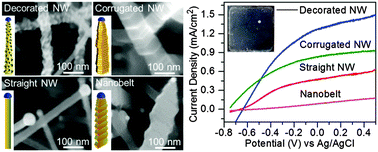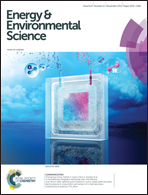Defect-rich decorated TiO2 nanowires for super-efficient photoelectrochemical water splitting driven by visible light†
Abstract
Oxygen vacancy defects are highly desirable for photoelectrochemical water splitting reactions of TiO2 nanomaterials because they act as electron donors and thereby enhance the electrical conductivity and charge transport property of TiO2. For TiO2 nanowires reported to date, oxygen vacancies are mainly generated by post-treatment of the as-synthesized nanowires. This comes with a disadvantage that oxygen vacancies are found to form just within a few tens of nanometers at the outer surface of these nanowires, and the photocurrent density is significantly reduced by two to three orders of magnitude when ultraviolet light is filtered out from the AM 1.5G light. Here, we demonstrate, for the first time, the controlled growth of 1D TiO2 nanostructures with different morphologies and with incorporation of oxygen vacancy defects on a Si substrate by a single-step, catalyst-assisted pulsed laser deposition (PLD) method. Photoelectrochemical water splitting measurements under simulated sunlight show that the decorated nanowires exhibit one of the highest photoactivity values in the visible region (>430 nm) reported to date, which represents 87% of the overall photocurrent. The higher activity in the visible region can be attributed to more conductive TiO2 nanostructures (i.e., with a larger amount of oxygen vacancy defects), and the enhanced charge transfer from the nanocrystallites to the core of the decorated nanowires.


 Please wait while we load your content...
Please wait while we load your content...